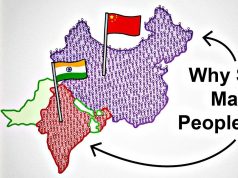Aprendendo inglês com vídeos é uma série de posts em que traremos para vocês vídeos acompanhados de transcrições e traduções, pois este é um material de altíssima qualidade para qualquer estudante de inglês. A grande maioria dos vídeos virão do YouTube, assim como forma de retribuir aos criadores dos vídeos incríveis que vamos usar, pedimos que você sempre dê o seu “Gostei” no vídeo (ao clicar para reproduzir o vídeo você verá a opção “gostei” no próprio vídeo).
Where Did English Come From? (Transcrição)
When we talk about English, we often think of it as a single language, but what do the dialects spoken in dozens of countries around the world have in common with each other, or with the writings of Chaucer? And how are any of them related to the strange words in Beowulf? The answer is that like most languages, English has evolved through generations of speakers, undergoing major changes over time.
By undoing these changes, we can trace the language from the present day back to its ancient roots. While modern English shares many similar words with Latin-derived romance languages, like French and Spanish, most of those words were not originally part of it.
Instead, they started coming into the language with the Norman invasion of England in 1066. When the French-speaking Normans conquered England and became its ruling class, they brought their speech with them, adding a massive amount of French and Latin vocabulary to the English language previously spoken there.
Today, we call that language Old English. This is the language of Beowulf. It probably doesn’t look very familiar, but it might be more recognizable if you know some German. That’s because Old English belongs to the Germanic language family, first brought to the British Isles in the 5th and 6th centuries by the Angles, Saxons, and Jutes.
The Germanic dialects they spoke would become known as Anglo-Saxon. Viking invaders in the 8th to 11th centuries added more borrowings from Old Norse into the mix. It may be hard to see the roots of modern English underneath all the words borrowed from French, Latin, Old Norse and other languages.
But comparative linguistics can help us by focusing on grammatical structure, patterns of sound changes, and certain core vocabulary. For example, after the 6th century, German words starting with “p,” systematically shifted to a “pf” sound while their Old English counterparts kept the “p” unchanged. In another split, words that have “sk” sounds in Swedish developed an “sh” sound in English.
There are still some English words with “sk,” like “skirt,” and “skull,” but they’re direct borrowings from Old Norse that came after the “sk” to “sh” shift. These examples show us that just as the various Romance languages descended from Latin, English, Swedish, German, and many other languages descended from their own common ancestor known as Proto-Germanic spoken around 500 B.C.E. Because this historical language was never written down, we can only reconstruct it by comparing its descendants, which is possible thanks to the consistency of the changes.
We can even use the same process to go back one step further, and trace the origins of Proto-Germanic to a language called Proto-Indo-European, spoken about 6000 years ago on the Pontic steppe in modern day Ukraine and Russia.
This is the reconstructed ancestor of the Indo-European family that includes nearly all languages historically spoken in Europe, as well as large parts of Southern and Western Asia. And though it requires a bit more work, we can find the same systematic similarities, or correspondences, between related words in different Indo-European branches.
Comparing English with Latin, we see that English has “t” where Latin has “d”, and “f” where latin has “p” at the start of words. Some of English’s more distant relatives include Hindi, Persian and the Celtic languages it displaced in what is now Britain.
Proto-Indo-European itself descended from an even more ancient language, but unfortunately, this is as far back as historical and archeological evidence will allow us to go. Many mysteries remain just out of reach, such as whether there might be a link between Indo-European and other major language families, and the nature of the languages spoken in Europe prior to its arrival.
But the amazing fact remains that nearly 3 billion people around the world, many of whom cannot understand each other, are nevertheless speaking the same words shaped by 6000 years of history.
De Onde Veio o Inglês? (Tradução)
Quando falamos da língua inglesa, normalmente imaginamos uma única língua, mas o que os dialetos falados em dúzias de países em todo o mundo têm em comum uns com os outros, ou com os escritos de Chaucer? E como qualquer um deles está relacionado com as estranhas palavras em Beowulf? A resposta é que, tal como a maioria das línguas, a língua inglesa evoluiu através de gerações de falantes, sofrendo grandes modificações com o passar do tempo.
Desfazendo essas modificações, podemos investigar a língua desde os dias atuais até suas antigas origens. Enquanto língua inglesa moderna tem muitas palavras semelhantes às das línguas românicas derivadas do latim, como o francês e o espanhol, a maioria dessas palavras não era parte disso (o inglês) originalmente.
Em vez disso, elas começaram a ser integradas à língua inglesa com a invasão dos normandos à Inglaterra, em 1066. Quando os normandos, falantes de francês, conquistaram a Inglaterra e se tornaram a classe dominante, trouxeram seu linguajar consigo, adicionando uma quantidade massiva de palavras do francês e do latim à língua inglesa que antes lá se falava.
Hoje, chamamos aquela língua de inglês antigo, a língua usada em Beowulf. Ela provavelmente não lhe soa muito familiar, mas talvez você a reconheça melhor se souber um pouco de alemão. Isso porque o inglês antigo pertence à família de línguas germânicas, trazidas às ilhas inglesas pela primeira vez nos séculos 5 e 6, pelos anglos, pelos saxões e pelos jutos.
Os dialetos germânicos que eles falavam ficariam conhecidos como anglo-saxões. Invasores vikings, do século 8 ao século 11, trouxeram mais adições vindas do nórdico antigo a essa mistura. Pode ser difícil enxergar as raízes da língua inglesa moderna sob todas as palavras emprestadas do francês, do latim, do nórdico antigo e de outras línguas.
Mas a linguística comparativa pode nos ajudar focando a estrutura gramatical, padrões de mudanças fonéticas e certo vocabulário central. Por exemplo, após o século 6, palavras alemãs iniciadas com “p” passaram sistematicamente ao som de “pf” enquanto suas semelhantes no inglês antigo mantiveram o “p” intacto. Em outro exemplo, palavras com sons de “sk” em sueco passaram a ter som de “sh” em inglês.
Ainda existem algumas palavras inglesas com o som “sk”, como “skirt” e “skull”, mas elas foram herdadas diretamente do nórdico antigo, que surgiu após a mudança do “sk” para o “sh”. Esses exemplos nos mostram que, tal como as diversas línguas românicas vieram do latim, o inglês, o sueco, o alemão e muitas outras línguas vieram de seu próprio ancestral comum, conhecido como protogermânico e falado por volta de 500 a.C. Uma vez que essa língua histórica jamais foi escrita, só podemos reconstruí-la comparando suas descendentes, o que é possível graças à consistência das mudanças.
Podemos até usar o mesmo processo para voltar um passo atrás e investigar as origens do protogermânico até uma língua chamada protoindo-europeu, falada cerca de 6 mil anos atrás na região da estepe pôntica, atuais Ucrânia e Rússia.
Ela é a ancestral reconstituída da família do indo-europeu, que inclui praticamente todas as línguas que já foram faladas na Europa e em grande parte do sul e do oeste da Ásia. Embora dê um pouco mais de trabalho, podemos encontrar as mesmas semelhanças sistemáticas, ou correspondências, entre palavras relacionadas em diferentes ramos do indo-europeu.
Comparando o inglês com o latim, vemos que, no inglês, usa-se o “t” onde, em latim, usa-se o “d”, e o “f” onde, em latim, usa-se o “p”, no início das palavras. Alguns dos parentes mais antigos da língua inglesa incluem o hindu, o persa e as línguas célticas que ela substituiu no local onde hoje fica a Grã-Bretanha.
O próprio protoindo-europeu veio de uma língua ainda mais antiga, mas, infelizmente, isso é o mais longe que evidências históricas e arqueológicas nos permitem ir. Muitos mistérios continuam fora de alcance, tais como se poderia haver uma possível ligação entre o indo-europeu e outras grandes famílias de línguas, bem como a natureza das línguas faladas na Europa antes de sua chegada.
Mas o mais impressionante é o fato de que quase 3 bilhões de pessoas no mundo, muitas das quais não conseguem entender umas às outras, estão ainda assim falando as mesmas palavras moldadas por 6 mil anos de história.
Glossário de Estudos
Dozens = Dúzias. Essa palavra é mais usada para enfatizar a grande quantidade de algo do que tens, ou “dezenas”, que usamos em Português.
Over time = Com o tempo, através do tempo, com o passar do tempo.
Coming into the language (Come into) = No sentido do texto, significa literalmente “ir para dentro” do idioma, ou seja, integrar-se ao idioma.
Go back = Voltar.
As far back as historical and archeological evidence will allow us to go. (As far back) = O mais longe que se pode chegar, o mais distante no passado.
Out of reach = Fora de alcance, que não se pode tocar, possuir, adquirir ou que não se pode entender.
Nevertheless = Apesar disso, não obstante, mesmo assim, ainda assim.
Espero que vocês tenham gostado do vídeo de hoje e da transcrição/tradução! Como sempre, não deixem de visitar o vídeo no Youtube e dar o seu “gostei”, pois assim vocês estão ajudando o trabalho dos criadores desses vídeos incríveis! Link para o vídeo no YouTube: https://www.youtube.com/watch?v=YEaSxhcns7Y Abração e bons estudos a todos vocês!














